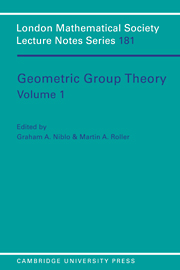Book contents
- Frontmatter
- Contents
- Preface
- List of Participants
- 1 Group Actions and Riemann Surfaces
- 2 The Virtual Cohomological Dimension of Coxeter Groups
- 3 The Geometric Invariants of a Group A Survey with Emphasis on the Homotopical Approach
- 4 String Rewriting — A Survey for Group Theorists
- 5 One Relator Products and High-Powered Relators
- 6 An Inaccessible Group
- 7 Isoperimetric and Isodiametric Functions of Finite Presentations
- 8 On Hibert's Metric for Simplices
- 9 Software for Automatic Groups, Isomorphism Testing and Finitely Presented Groups
- 10 Proving Certain Groups Infinite
- 11 Some Applications of Small Cancellation Theory to One-Relator Groups and One-Relator Products
- 12 A Group Theoretic Proof of the Torus Theorem
- 13 N-Torsion and Applications
- 14 Surface Groups and Quasi-Convexity
- 15 Constructing Group Actions on Trees
- 16 Brick's Quasi Simple Filtrations and 3-Manifolds
- 17 A Note on Accessibility
- 18 Geometric Group Theory 1991 Problem List
9 - Software for Automatic Groups, Isomorphism Testing and Finitely Presented Groups
Published online by Cambridge University Press: 15 March 2010
- Frontmatter
- Contents
- Preface
- List of Participants
- 1 Group Actions and Riemann Surfaces
- 2 The Virtual Cohomological Dimension of Coxeter Groups
- 3 The Geometric Invariants of a Group A Survey with Emphasis on the Homotopical Approach
- 4 String Rewriting — A Survey for Group Theorists
- 5 One Relator Products and High-Powered Relators
- 6 An Inaccessible Group
- 7 Isoperimetric and Isodiametric Functions of Finite Presentations
- 8 On Hibert's Metric for Simplices
- 9 Software for Automatic Groups, Isomorphism Testing and Finitely Presented Groups
- 10 Proving Certain Groups Infinite
- 11 Some Applications of Small Cancellation Theory to One-Relator Groups and One-Relator Products
- 12 A Group Theoretic Proof of the Torus Theorem
- 13 N-Torsion and Applications
- 14 Surface Groups and Quasi-Convexity
- 15 Constructing Group Actions on Trees
- 16 Brick's Quasi Simple Filtrations and 3-Manifolds
- 17 A Note on Accessibility
- 18 Geometric Group Theory 1991 Problem List
Summary
Introduction
The purpose of this note is to give a brief description of some software that has been developed by the authors (partly in collaboration with David Epstein), and which was demonstrated by them at the Workshop at the University of Sussex. It is all written in the C language and designed for use on UNIX systems. It is available for distribution (via ftp or SUN cartridge) free of charge from either of the authors, with source code and documentation included, mainly in the form of UNIX-style manual entries. Input and output is all done using files in a specially designed format. Usually, the user only needs to create files containing group presentations prior to running the programs. There are three principal components of this package, which we shall describe individually.
Automata
This is a sequence of programs that is designed to compute the automatic structure of a short-lex automatic group. For general information on automatic groups see [ECHLPT 92], and for a detailed description of the algorithms employed in these programs see [EHR 91]. These programs were written together with David Epstein.
Let G = (X | R) be a finitely presented group, where X is ordered and closed under inversion. For each g ∈ G, let w(g) be the lexicographically least (using the given ordering of X) amongst the shortest words in X that represent g. Then G is said to be short-lex automatic (with respect to the ordered set X) if the following hold.
- Type
- Chapter
- Information
- Geometric Group Theory , pp. 120 - 125Publisher: Cambridge University PressPrint publication year: 1993



